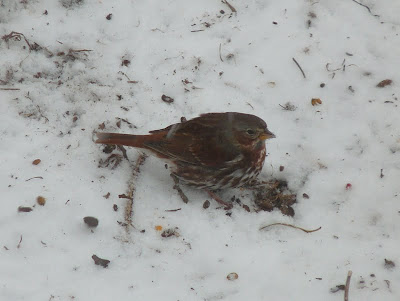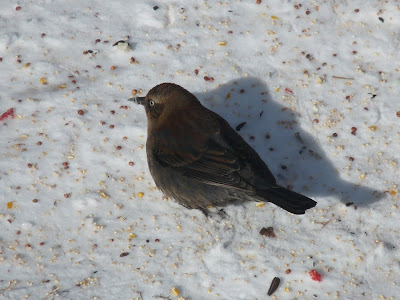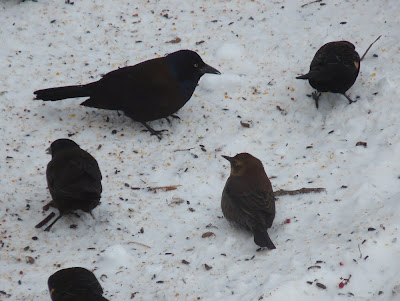Before we left Frank wanted to check a nearby stand of birch trees for winter finches. The sizable patch did not disappoint as he found about 35 (yes, thirty-five!) Common Redpolls feeding there. It was early and even darker than usual with the nor'easter approaching, so this was the best I could do for a photo.

We got wonderful looks at the redpolls until a plane taking off from the nearby airport flushed them. From here, we drove to the Stratford open space area behind DeLuca field since it was near low tide. I walked the perimeter and checked what is left of the brushy tangles while he looked for shorebirds on the open flats. Stratford removed much of what was a great habitat here while adding paths for people to walk and bike on. It may have been unattractive, but it was very useful to birds. Because of this, we did not turn up too much here beyond Northern Mockingbird, a few sparrows like Song, American Tree, and House, and plenty of the usual gulls.
Next, we split up to cover more ground in less time. Frank went to the foot of Cove Place to check out the massive group of sea ducks on Long Island Sound that has been there for most of the fall and this week of winter while I went to the Birdseye St. boat ramp. There I found a couple of Pied-billed Grebes and an impressive total of 18 American Coot. I also saw two Northern Harriers hunting the marshes in the Housatonic. Frank discovered the sea ducks were close to shore and in great quantity.

He estimated 3,000 White-winged Scoter, 3,000 Greater Scaup, and 500 Surf Scoter. He picked out 1 Black Scoter and 10 Lesser Scaup. When I got there we both enjoyed views of 2 female King Eiders, a nice rarity for the CBC. These were conservative estimates - there may have been even a couple thousand more birds.
 See the two brown ducks in the bottom of the photo closest to us, facing towards the center of the picture and at one another? Female King Eiders
See the two brown ducks in the bottom of the photo closest to us, facing towards the center of the picture and at one another? Female King EidersFrank and I moved on to CAS' own Stratford Point next. We hoped to find all of the ducks we needed plus passerines that frequent the point’s open coastal grasslands habitat. As the strengthening northeast wind bore down on us, we managed to locate Common Goldeneye, Gadwall, American Wigeon, American Black Duck, Red-breasted Merganser, and more. Frank even saw a Double-crested Cormorant on the breakwater, rare to see in winter instead of Great Cormorant. However, no Snow Buntings, Savannah Sparrow, or American Pipit were seen, a few of the species we hoped to find in upland areas. I saw another Northern Harrier hunting over the grasslands while being tossed about by the wind.
By this point, around 11AM, snow started to fall and collected very quickly. In a matter of minutes, roadways were covered and it was becoming decidedly...well, "unbirdy". I am sure everyone knows what that means. I decided to head home and check a couple spots along the way, including Shakespeare Theatre. I did not add anything to our list for the day, but Frank walked in to Short Beach and found quite a bit. This included an American Pipit, 25 Horned Larks, a Lapland Longspur, and a wintering Great Egret. On his way home he also had a Wilson's Snipe at the boat ramp since it was high tide by that time and a Northern Pintail at Raven Park Pond on East Main St.
Another reason I wanted to get home quickly was to fill up and watch my feeders. I knew the rapidly declining conditions would send hungry birds my way. I was glad to see this Fox Sparrow appear again to be included on the count day.

It may not have been your typical Christmas Bird Count, but it was still successful and a lot of fun.
Photos © Scott Kruitbosch








































